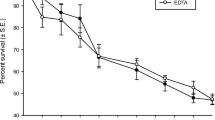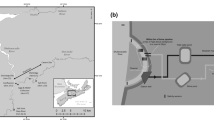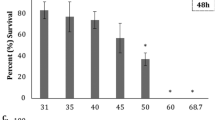Abstract
Desalination is a promising sustainable solution to meet growing water needs of cities across the United States. However, the environmental impacts of the resulting filtrate (brine) discharged to surface water need to be evaluated before large-scale desalination can be successful in the United States. Developing fish are especially sensitive to changes in salinity and varying ionic composition. Limited research is available on the impacts of hypersalinity on chronic vertebrate embryonic development, particularly on sublethal effects. To investigate this, Japanese medaka (Oryzias latipes) embryos were treated with: (1) graphite filtered freshwater; (2) artificial seawater [17, 35, 42, 56, and 70 parts per thousand (ppt)]; (3) effluent from a desalination facility at Monterey Bay Aquarium, CA, diluted to 75, 50, and 25% with 35 ppt artificial seawater to simulate mixing (39, 42, 46, and 50 ppt); (4) artificial San Joaquin River water (CA, USA) (9, 13, and 17 ppt); and (5) artificial San Joaquin River water diluted to 75, 50, and 25% with artificial seawater to simulate estuarine mixing in the San Francisco Bay (13, 19, 24, and 30 ppt). Percent hatch, survival post hatch, deformities, swim bladder inflation, and median day to hatch were recorded to calculate EC50 (50% effect concentration) and NOEC (no observable effect concentration) values. No significant difference was observed between artificial seawater and Monterey Bay aquarium effluent (EC50 = 45–55 ppt). However, San Joaquin River water decreased survival post hatch and increased deformities in comparison to artificial seawater and San Joaquin River water mixed with seawater, suggesting that unique ion compositions may play a role in embryo and larval toxicity.




Similar content being viewed by others
References
Cañedo-Argüelles M, Hawkins CP, Kefford BJ, Schäfer RB, Dyack BJ, Brucet S, Buchwalter D, Dunlop J, Frör O, Lazorchak J, Coring E, Fernandez HR, Goodfellow W, González Achem AL, Hatfield-Dodds S, Karimov BK, Mensah P, Olson JR, Piscart C, Prat N, Ponsá S, Schulz C-J, Timpano AJ (2016) Ion-specific standards are needed to protect biodiversity. Science 351:914–916
Cooley H, Gleick PH, Wolff G (2006) Desalination, with a grain of salt: a California perspective. Pacific Institute for Studies in Development, Environment, and Security, Oakland
Dorn PB, Rodgers JH Jr (1989) Variability associated with identification of toxics in NPDES effluent toxicity tests. Environ Toxicol Chem 8:893–902
Goodfellow WL, Ausley LW, Burton DT, Denton DL, Dorn PB, Grothe DR, Heber MA, Norberg-King TJ, Rodgers JH Jr (2000) Major ion toxicity in effluents: a review with permitting recommendations. Environ Toxicol Chem 19:175–182
Havonec TA (2015) Synthetic sea salts: are they all equal? A primer on Instant Ocean®: the premier sea salt for your marine aquarium. Marineland, Spectrum Brands, Blacksburg
Inoue K, Takei Y (2009) Diverse adaptability in oryzias species to high environmental salinity. Zool Sci 19:727–734
Iso S, Suizu S, Maejima A (1994) The lethal effect of hypertonic solution and avoidance of marine organisms in relation to the discharged brine from desalination plant. Desalination 97:389–399
Jenkins S, Paduan J, Roberts P, Schlenk D, Weiss J (2013) Management of brine discharges to coastal waters: recommendations of a science advisory panel. Southern California Coastal Water Research Project, Costa Mesa
Kestemont P, Jourdan S, Houbart M, Melard C, Paspatis M, Fontaine P, Cuvier A, Kentouri M, Baras E (2003) Size heterogeneity, cannibalism and competition in cultured predatory fish larvae: biotic and abiotic influences. Aquaculture 227:333–356
Kingsley E, Modisette N, Phillips R (2014) Development and use of nitrate and total ammonia testing procedures at the Monterey Bay Aquarium. 2nd Aquality Symposium: Water Quality Treatment in Zoos and Aquariums
Kirchen RV, West WR (1976) The Japanese medaka: its care and development. Carolina Biological Supply Company, Burlington
Lattemann S, Hopner T (2008) Environmental impact and impact assessment of seawater desalination. Desalination 220:1–15
Litchfield JT Jr, Wilcoxon F (1949) A simplified method for evaluating dose-effect experiments. J Pharmacol Exp Ther 96:99–113
Marty GD, Hinton DE, Cech JJ (1995) Oxygen consumption by larval Japanese Medaka with inflated or uninflated swim bladders. Trans Am Fish Soc 124:623–627
Mount DR, Gulley DD, Hockett JR, Garrison TD, Evans JM (1997) Statistical models to predict the toxicity of major ions to Ceriodaphnia dubia, Daphnia magna and Pimephales promelas (fathead minnows). Environ Toxicol Chem 16:2009–2019
Schlenk D, Zubcov N, Zubcov E (2003) Effects of salinity on the uptake, biotransformation, and toxicity of dietary seleno-l-methionine to rainbow trout. Toxicol Sci 75:309–313
Soucek DJ (2007) Comparison of hardness- and chloride-regulated acute effects of sodium sulfate on two freshwater crustaceans. Environ Toxicol Chem 26:773–779
Soucek DJ, Kennedy AJ (2005) Effects of hardness, chloride, and acclimation on the acute toxicity of sulfate to freshwater invertebrates. Environ Toxicol Chem 24:1204–1210
Stekoll MS, Smoker WW, Failor-Rounds BJ, Wang IA, Joyce VJ (2009) Response of the early developmental stages of hatchery reared salmonids to major ions in a simulated mine effluent. Aquaculture 298:172–181
von Westernhagen H (1998) Sublethal effects of pollutants on fish eggs and larvae. In: Hoar DS, Randall DJ (eds) Fish physiology, vol XIa. Academic Press, San Diego, p 253
Voorhees JP, Phillips BM, Anderson BS, Siegler K, Katz S, Jennings L, Tjeerdema RS, Jensen J, Carpio-Obeso MD (2013) Hypersalinity toxicity thresholds for nine California ocean plan toxicity test protocols. Arch Environ Contam Toxicol 65:665–670
Wang N, Dorman RA, Ingersoll CG, Hardesty DK, Brumbaugh WG, Hammer EJ, Bauer CR, Mount DR (2016) Acute and chronic toxicity of sodium sulfate to four freshwater organisms in water-only exposures. Environ Toxicol Chem 35:115–127
Acknowledgements
This research was supported by the National Water Research Institute and Southern California Salinity Coalition Fellowship, a National Research Service Award Institutional Training Grant (2T32ES018827-06), and the University of California-Riverside/Agricultural Experiment Station Resource Allocation Program.
Author information
Authors and Affiliations
Corresponding author
Ethics declarations
Conflict of interest
The authors declare no conflict of interest.
Electronic supplementary material
Below is the link to the electronic supplementary material.
Rights and permissions
About this article
Cite this article
Kupsco, A., Sikder, R. & Schlenk, D. Comparative Developmental Toxicity of Desalination Brine and Sulfate-Dominated Saltwater in a Euryhaline Fish. Arch Environ Contam Toxicol 72, 294–302 (2017). https://doi.org/10.1007/s00244-016-0354-9
Received:
Accepted:
Published:
Issue Date:
DOI: https://doi.org/10.1007/s00244-016-0354-9




